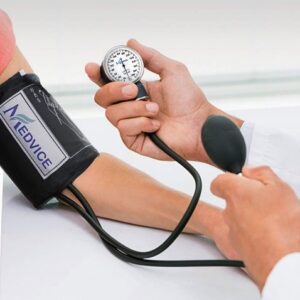Low blood pressure, also known as hypotension, is a phenomenon many of us have added to the list of yet, just another “thing” to deal with when living with a spinal cord injury (SCI). This is especially true for those with higher injuries (T6 and higher).
With that in mind, we wanted to write an article that might help explain the circumstances that can lead to these bouts of low blood pressure as well as some tips for dealing with or avoiding it altogether. Blood pressure is the force that moves blood through our circulatory system distributing oxygen and nutrients to our tissues and organs throughout the body. But how does having an SCI contribute to low blood pressure? An SCI can disrupt the reflexes that make blood vessels constrict and relax. When blood vessels relax too much, there isn’t enough force to keep blood flowing efficiently, as it did before, causing a decrease in blood pressure. As a result, blood will start to pool in your arms and legs, reducing the total amount of blood circulating back to your heart and in turn your brain, setting you up for the nasty dizziness to occur.
The optimal blood pressure for a healthy able-bodied person is considered to be 130/80 for systolic and diastolic blood pressure measurements, respectively. (The systolic is the upper number-130 and the diastolic is the lower number-80).
So, the first type of low blood pressure we will discuss is orthostatic hypotension. It is a condition characterized by low blood pressure after sitting up or standing up too quickly. It occurs when blood pools in the lower body, specifically the legs and abdomen, and can lead to a variety of debilitating symptoms, including:
- Bouts of dizziness
- Lightheadedness
- Impaired vision
- Nausea
- Fainting
- Muscle weakness
- Shortness of breath
These symptoms are all characteristic of reduced blood flow to the brain. And although anyone can get orthostatic hypotension, it is significantly more prevalent among people with an SCI. And it’s more common in the first couple of weeks following an SCI, but it can become a chronic issue for some.
The best ways to manage orthostatic hypotension and increase your blood pressure with an SCI include:
- Taking your time getting up – If you get up and suddenly start to feel disoriented, sit or lay down again until the dizziness goes away. You likely sat or stood up too fast.
- Staying hydrated – Another effective way to prevent drops in blood pressure is to drink enough water. Dehydration can lower fluid volume in the body and result in unstable blood pressure.
- Exercising regularly – Regular exercise is essential for promoting efficient blood flow. Due to paralysis, many spinal cord injury patients tend to not move enough to counteract blood pooling in the arms and legs.
- Wear an abdominal binder and compression stockings – these may help to prevent blood pooling and increase circulation throughout the body.
- Increasing sodium intake – Increasing your sodium intake will help elevate blood pressure. However, consuming too much sodium can be harmful (even for those with low blood pressure) so check first with your doctor to try to find a good balance.
- Taking medications – Doctors may prescribe medications called vasopressors that cause your blood vessels to constrict and promote circulation.
Generally, orthostatic hypotension after spinal cord injury can be effectively managed through a few simple lifestyle adjustments like getting up slowly and staying hydrated. But if it continues to be a problem follow up with your healthcare provider.
Do not disregard the symptoms. If you ignore the early signs you might faint. It’s important to get in a reclined position and get your legs raised higher than your heart if possible. This will get the blood flowing back toward your head. Once the dizziness passes, attempt to sit up again, but slowly.
Everyone has a unique spinal cord injury blood pressure and blood flow; it’s a matter of getting it to the optimal point that minimizes potential harm.
It’s all good.
Patty, BSN, RNC
The Rollin’ RNs ™
Reference:
https://www.sralab.org/lifecenter/resources/spinal-cord-injury-complications-orthostatic-hypotension

